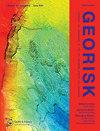On worst-case correlation length in probabilistic 3D bearing capacity assessments
IF 4.8
3区 工程技术
Q1 ENGINEERING, GEOLOGICAL
Georisk-Assessment and Management of Risk for Engineered Systems and Geohazards
Pub Date : 2022-10-14
DOI:10.1080/17499518.2022.2132262
引用次数: 3
Abstract
ABSTRACT Correlation length or scale of fluctuation (SOF) is often used as a primary parameter in defining the spatial correlation characteristics of varying soil properties. However, geotechnical site investigations are rather limited so that proper determination of correlation length is not always possible. The concept of a worst-case correlation length thus has important implications in reliability-based designs. In the case of insufficient information, the worst-case correlation length can be used to conservatively estimate the reliability or probability of failure of geotechnical structures. However, the definition of the worst-case correlation length in the literature is not very clear and has been seen in some investigations to not exist. This paper, in the context of bearing capacity of 3D spatially varying soils, investigates the worst-case correlation length based on different definitions to clarify past findings. Further analyses provide insight into practical applications, where the impact of site sampled data and realistic uncertainties are considered. Using realistic values of the coefficient of variation, and taking account of the distance at which site investigation is likely to occur from the loaded area, a worst-case SOF is identified and found to be similar using all definitions.概率三维承载力评估中的最坏情况相关长度
相关性长度或波动尺度(SOF)通常被用作定义不同土壤性质的空间相关性特征的主要参数。然而,岩土工程现场调查相当有限,因此不可能总是正确确定相关长度。因此,最坏情况相关长度的概念在基于可靠性的设计中具有重要意义。在信息不足的情况下,最坏情况下的相关长度可用于保守估计岩土结构的可靠性或失效概率。然而,文献中对最坏情况相关长度的定义不是很清楚,并且在一些调查中发现不存在。本文在三维空间变化土壤承载力的背景下,基于不同的定义研究了最坏情况下的相关长度,以澄清过去的发现。进一步的分析可以深入了解实际应用,其中考虑了现场采样数据的影响和现实的不确定性。使用变化系数的实际值,并考虑到现场调查可能与装载区域的距离,确定了最坏情况下的SOF,并使用所有定义发现其相似。
本文章由计算机程序翻译,如有差异,请以英文原文为准。
求助全文
约1分钟内获得全文
求助全文
来源期刊
CiteScore
8.70
自引率
10.40%
发文量
31
期刊介绍:
Georisk covers many diversified but interlinked areas of active research and practice, such as geohazards (earthquakes, landslides, avalanches, rockfalls, tsunamis, etc.), safety of engineered systems (dams, buildings, offshore structures, lifelines, etc.), environmental risk, seismic risk, reliability-based design and code calibration, geostatistics, decision analyses, structural reliability, maintenance and life cycle performance, risk and vulnerability, hazard mapping, loss assessment (economic, social, environmental, etc.), GIS databases, remote sensing, and many other related disciplines. The underlying theme is that uncertainties associated with geomaterials (soils, rocks), geologic processes, and possible subsequent treatments, are usually large and complex and these uncertainties play an indispensable role in the risk assessment and management of engineered and natural systems. Significant theoretical and practical challenges remain on quantifying these uncertainties and developing defensible risk management methodologies that are acceptable to decision makers and stakeholders. Many opportunities to leverage on the rapid advancement in Bayesian analysis, machine learning, artificial intelligence, and other data-driven methods also exist, which can greatly enhance our decision-making abilities. The basic goal of this international peer-reviewed journal is to provide a multi-disciplinary scientific forum for cross fertilization of ideas between interested parties working on various aspects of georisk to advance the state-of-the-art and the state-of-the-practice.

 求助内容:
求助内容: 应助结果提醒方式:
应助结果提醒方式:


